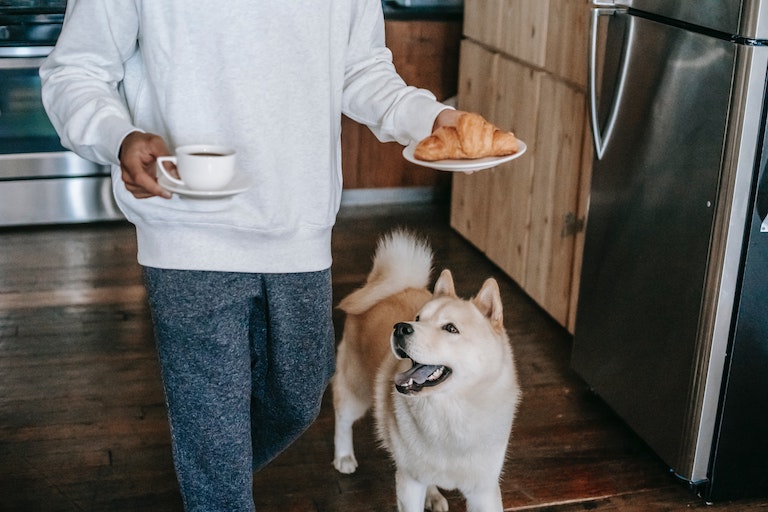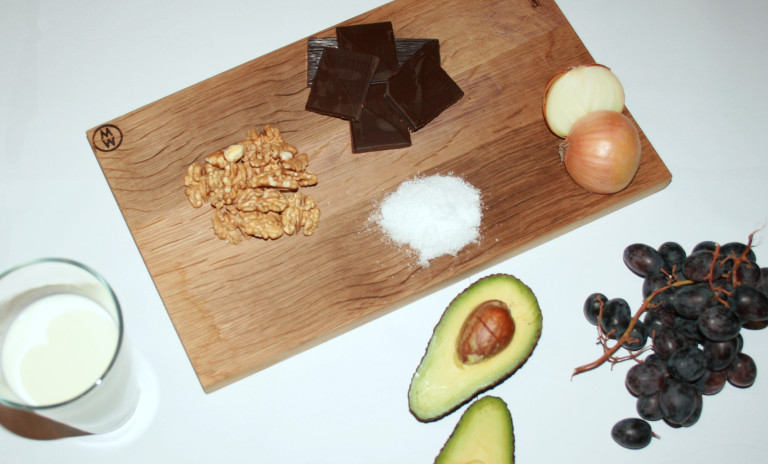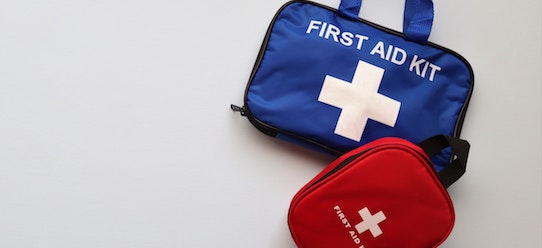What NOT to feed your dog
There are a lot of different ways for dogs to get access to food that is not explicitly for them. Maybe it’s your dog’s adorable face at the dinner table that did it, maybe they took matters into their own paws and helped themselves to the plate left on the counter. The problem is that not everything we eat is safe for dogs as well. While some products put strain on your dog’s digestion, others can lead to serious poisoning and even death if spotted too late.

Chocolate
Chocolate contains theobromine (the darker the chocolate the more there is) and even a small dose is toxic for dogs. Symptoms include vomiting, diarrhoea, and shaking, and can be fatal if not treated immediately, so if your dog ingests chocolate, take them to a vet right away.
Onions
When feeding your dog leftovers, make sure that they don’t contain any kind of onion, no matter if raw, cooked, or powdered. Onions cause anaemia by destroying red blood cells and lead to symptoms such as vomiting, diarrhoea, weakness, excessive salvation, and shaking.
Grapes and raisins
Though the reason for this is not yet clear, dogs of different sizes and breeds react differently to eating grapes. Since there is no way of knowing beforehand whether or not your dog tolerates them, steering clear of them altogether is the safest option. Symptoms include vomiting, diarrhoea, stomach pains and, ultimately, kidney failure if the intoxication remains undetected.

Xylitol and other sweeteners
Xylitol, a sugar substitute mainly sourced from birch trees, has found its way into many products we consume on a daily basis. While it is harmless to humans, even the smallest dose can be dangerous for dogs. Vomiting, weakness and seizures are signs of rapidly dropping blood sugar levels, while some dogs can even suffer a liver failure, so keep an eye on the product’s list of ingredients, peanut butter or chewing gum for example, to make sure it doesn’t contain xylitol or other sweeteners.
Walnuts and Macadamia nuts
What makes walnuts dangerous for your dog is a fungus that they’re often infested by. While a store-bought walnut probably won’t do your dog any harm, the ones that are found lying around in the garden or by the side of the road have a higher risk of having contracted the fungus. Symptoms to look out for include severe seizures and vomiting.
Macadamia nuts contain toxins that attack your dog’s digestive and nervous system, severely damaging it in the process. Your dog may exhibit symptoms such as a stiff gait, convulsions and vomiting.
Avocados
While humans in recent years have been celebrating the avocado for its health benefits, they do the opposite for dogs. The peel, flesh and pit of an avocado contain persin, which is poisonous to dogs, causing disruptions in the cardiac muscles and potentially resulting in death.

Cooked bones and chicken bones
While dogs can safely enjoy raw bones from cattle or pigs, any cooked bones, as well as chicken bones, are off limits, as they splinter easily and can cause injuries to your dog’s throat and intestines.
Stone fruits
The danger of stone fruits lies mainly within their pits. If swallowed, they can cause injuries inside your dog’s intestines or an intestinal obstruction. Additionally, a chewed up pit releases hydrocyanic acid, which leads to neurological deficiencies. If you have a garden, fruit that has fallen off trees is a potential danger and should be cleared away in time.
Dairy
While it is not toxic per se, feeding your dog dairy products in large quantities, such as milk, yoghurt, and cheese, can lead to diarrhoea.
Minimizing the risk of poisoning
Knowing which products are not safe to feed your dog can keep you from inadvertently causing damage to your dog’s health. Unfortunately, as most dogs are food driven, some things are out of your control. If your dog smells something that they think belongs into the ‘edible’ category, it’s going to go in their mouths, and fast. However, there are some precautions you can take to minimize this risk.
Inside your home, keep food that’s not meant for your dog out of their reach by storing it in high places and always making sure that it’s closed properly. Guests and family members should be made aware of the danger they could put your dog in if they mindlessly feed them things off the table, no matter how good the intention.
Some house plants are poisonous as well, so either make them dog – and especially puppy safe – or invest time in training your dog to leave them alone.
Outside your home, where you naturally have less control over things, proper training is a great asset. A dog with a habit of gobbling down everything they find lying by the side of the road has a higher risk of one day eating something that can become dangerous to them. Breaking that habit is hard work but will ultimately make your outside adventures safer and less stressful.
What to do if my dog shows signs of intoxication

Not every sign of poisoning means that it’s life-threatening, however, it is better to be safe than sorry. The moment you notice your dog showing signs of poisoning, don’t hesitate and take them to the vet immediately. If you know what your dog has eaten, take a sample with you to give the vet a better chance of finding out what they’re dealing with and try to estimate or remember how much of it your dog has consumed.
For emergencies, stock your first aid kit with charcoal tablets. They can bind the toxins in the gastrointestinal tract and keep them from being absorbed into the bloodstream. This can buy you some time until you reach the vet. Consult a professional for the right dosage and how to administer the tablets correctly.
The possibility of your dog poisoning themselves is, understandably, a great source of anxiety for most dog owners. By minimizing the risks you have control over, and consequently reacting fast once you detect symptoms, you are doing the best you can to keep your dog safe and healthy.